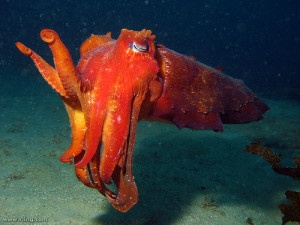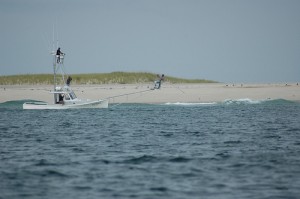We have much more to do and your continued support is needed now more than ever.
June Ocean Wildlife Roundup: Shark Chomps Giant Squid, Seals on Camera, Cuttlefish in Trouble
We spend lots of time on Wildlife Promise talking to you about amazing animals in the U.S. and elsewhere. But in my opinion, we don’t use nearly enough digital ink on marine life. I hope we can remedy that in part by putting out a monthly blog digest featuring a few odd or important news items about ocean creatures of all types. Enjoy, and please let me know what I missed.
Australia’s Giant Cuttlefish in Trouble as Weak Spawning Season Continues

This summer, numbers are way down.
Australia’s ABC Radio recently interviewed a local commercial fisherman who reported that he has only seen four this year—rather than the usual “hundreds of thousands.” Other news outlets have been picking it up too.
Researchers say the low numbers are cause for concern, and they don’t yet know what’s causing the trend (though “BHP Billiton’s proposed desalination plant” nearby probably won’t help. It would reportedly pour “huge quantities of hypersaline wastewater” into Spencer Gulf and make the area unpalatable for a variety of species). A new study finds that the cuttlefish breeding colony had decreased by 78% in the past decade, and last year marked a record low.
Plan to Exonerate Hawaiian Monk Seals Relies on Reality-TV-style Cameras

The image rehabilitation plan comes as local fishermen ramp up claims that the seals have been depleting area fish stocks. Recent cases of people pestering—and in some cases killing—the seals have come partly as a reaction to these rumors, and spurred scientists to “glue submersible cameras onto the seals’ backs, using the footage to prove to fishermen the animals are not harming their way of life.”
You can find out more about habitat threats to monk seals or read Les Welsh’s blog post from April about people intentionally killing the seals in the waters around Kaua’i (and how you can help).
Video: Blue Shark Chomps Giant Squid
Giant squid are mysterious, awesome and locked in an eternal arms race with sperm whales. Live sightings are so rare that even footage of a recently dead Architeuthis is a pretty big deal. Recently, Australian angler and journalist Al McGlashan came across a largely-intact carcass whose bright red coloration indicated it had died recently. While he filmed, a blue shark tore into the squid, thus launching the best cephalopod viral phenomenon of 2012 (so far…I eagerly await your videos of octopuses singing ‘Call Me, Maybe’). Take a look at Field & Stream’s exclusive full-length video and photos right this second.
[youtube]http://www.youtube.com/watch?v=Iz_8BDfZEc4[/youtube]
Canadian Lobster is Blue, Yet in Decent Spirits
Canadian lobster boat captain Bobby Stoddard caught a lobster in early May that resembled a giant Avatar cat person. That’s the way we say ‘it was blue’ in America now.
Blue lobsters do occur, but they’re uncommon. According to The University of Maine’s Lobster Institute, “only an estimated one in two million lobsters is blue” (which makes them rare, but not quite as rare as live, naturally red or yellow lobsters, which are estimated at one in ten million and one in 30 million, respectively). Blue lobsters come about due to “a genetic defect that causes the lobster to produce an excessive amount of a particular protein.”
You can learn more about invertebrates in our Wildlife Library.
Manta Ray Ultrasound Sheds Light on Liquid Oxygen Intake
A study recently published in Biology Letters is the first to show how manta ray embryos get oxygen, based on video from an ultrasound performed on a pregnant ray in 2008.
Though manta rays, like many other cartilaginous fish, give birth to live young, they lack an oxygen-giving umbilical cord or placenta. According to researchers, “the baby ray was raising and lowering its jaw, pumping uterine fluid in through its mouth and spiracle.” The continuous regulated flow of the fluid over the ray’s gills allowed the embryo to extract oxygen (the baby was “a healthy female, 2 meters from wingtip to wingtip and weighing 50 kilograms” at birth). According to Taketeru Tomita, a fish biologist at Hokkaido University Museum, this is the first time that scientists have observed fetal viviparious vertebrates pumping liquid to extract oxygen.
Great Whites Summering in Cape Cod

Researchers say the sharks were drawn to the area by “a growing seal population on Monomoy Island,” redoubt of migrating birds and other non-humans for hundreds of years. They haven’t come close enough to tourist beaches to warrant any official warning, though mayhem will presumably occur if the star-crossed Brody family gets too close.
For more on ocean creatures, see Kevin Coyle’s post from last year about animals’ various methods of swimming or my post about the Top 5 Real Sea Serpents (including the giant squid). You can also check out an article about sperm whales and the threat posed to them after the oil spill in the Gulf of Mexico.
If you’ve seen a story that you think should be covered in the next Ocean Wildlife Roundup, please let me know in the comments below, email me at greenbergm@nwf.org, or tell me on Twitter @MaxTGreenberg.





















